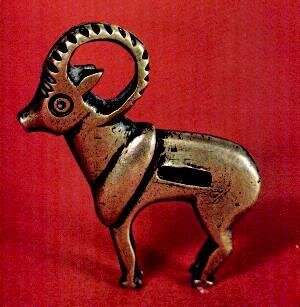A brief history of locks, locksmiths in Iran

TEHRAN – Available evidence suggests that locks have been made in Iran since at least the second millennium BC.
The most ancient lock, dating to the 13th century BC, was excavated at Tchogha Zanbil, a UNESCO World Heritage in southwest Iran. The lock consisted of a bolt and a tumbler and was probably used on a wooden door, according to Encyclopedia Iranica.
Experts say it is possible that the stone door of the tomb of the Achaemenid Artaxerxes III (r. 359-38 BC) built into the mountainside at Persepolis was secured by such a lock. The doors of the tomb consist of two solid stone slabs about 1.5 m high and 1.5 m wide with upper and lower corner pivots that revolved in round holes: a circular keyhole about six cm in diameter is on one panel, and a boxlike catch on the other. It can be assumed that the only mechanism that would work in such circumstances was a toothed-bolt lock, probably made of wood with a metal key.
Numerous mechanisms are found in Iranian padlocks, including barbed spring, bent spring, helical spring, shackle spring, notched shackle, hook and revolving catch, and notched shackle with rotating discs, as well as combination and multiple mechanisms.
Until not long ago, every bazaar had a section for locksmiths (bazaar-e ghoflsazha), but the importation of machine-made locks from the West drove the locksmiths out of the city bazaars. Those in the villages, however, managed to survive until the 1970s.
Locks have also played an important role in popular beliefs. Pregnant women were hoping to prevent miscarriage, wearing a small lock on a cord around their waist.
In addition to animals, many new shapes for locks made of steel were inspired by objects and vessels such as the cradle, kashkul (a bowl in which dervishes put the alms and food given to them), suitcase, and lantern, as well as all kinds of geometric shapes.
Talismanic locks constitute a great number of locks and come in all shapes. These are often small and made of silver or steel inscribed with talismanic writing, and they have various functions, such as protecting a child from the evil eye, “locking” an enemy's tongue, and so forth.
Large wooden fixed locks, known in Iran as kolun, were and are still used on the entrance doors of houses and gates in villages, bazaar series, and caravansaries, and they are all made of wood with metal or wooden keys.
Fixed locks for chests and small boxes, however, are made of metal. It seems that for such containers Iranians have preferred padlocks (qofl-e aviz) rather than fixed locks, since only a few metal fixed locks have come to light so far, among them is a fish-shaped steel padlock of the Timurid period (15th century).
In contrast to the rarity of surviving fixed locks, padlocks have been made in great numbers in Iran. The earliest existing padlocks are from the Sasanian period (ca. 224-651 CE). One from this group, which is now in the National Museum of Iran, was unearthed in Rudbar, not far from the Caspian Sea, in 1966.
In addition to the above-mentioned padlocks, the door of the tomb of Esther and Mordechai in Hamadan belonging to the Seljuk period (1040-1194) may have been locked by a padlock. This door, a solid slab of stone (about 1.20 x 90 m), is believed to have been originally from a structure of the time of Xerxes I (r. 486-65 BC). The present method of securing the door consists of an iron bar that rests inside the wall when the door is open and comes out of the wall when it is locked. To gain entry, the person outside must reach the padlock through a hole in the door.
Throughout the Islamic period in Iran, locks were made in all shapes and sizes. In the first centuries after the introduction of Islam (7th-9th centuries) in Iran, locks followed the same style as those of the Sasanians.
According to the Encyclopedia, from the 10th century onward, however, lock making went through major changes. In addition to the previously mentioned shapes, figural locks in the form of animals and birds became popular. Nearly all animals, such as the horse, lion, goat, ram, camel, rabbit, and water buffalo, as well as fish and all kinds of birds, were fashioned in locks.
With the rise of the Safavids (1501-1722) to power, there was a major evolution in lock making. The Safavids' love of steel arms and other steel implements encouraged locksmiths to use this metal for locks, which were previously made of bronze and brass.
AFM/MG
Leave a Comment